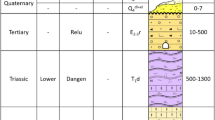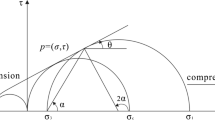Abstract
Floor heave disasters easily occur along tunnels in deeply buried, weak, anisotropic rock masses with high in situ stress. The previously presented floor heave mechanical models (buckling failure, shear dislocation failure, and slip line field theory) do not consider the processes of stress release, transfer, and concentration, and only the initial in situ stress state can be analyzed with these models, i.e., they are static mechanical models. Therefore, the combined finite–discrete element numerical method (FDEM) is employed here to study floor heave tunneling in anisotropic rock masses to propose a new floor heave mechanical mechanism based on progressive fracture and swelling processes and the influences of the in situ stress (lateral pressure coefficient) and the layer thickness are also investigated. The simulation results indicate that (1) the essential mechanical mechanism of floor heave is X-shaped conjugate shear failure accompanied by tensile failure caused by the concentrated maximum horizontal stress present after tunneling; the shallow rock fragments cannot bear the enormous concentrated horizontal stress, and thus, this stress is transferred deeper into the intact rock mass, further causing the shear and tensile fractures to propagate downward (a progressive evolution); (2) for anisotropic floor rock masses, in addition to the X-shaped conjugate shear fractures, shear fractures parallel to the bedding plane and tensile fractures perpendicular to the bedding plane form; (3) with the change in the in situ stress lateral pressure coefficient, the failure mode directly under the floor remains almost unchanged, but it will have a significant impact on the rock mass on both sides of the floor; and (4) the layer thickness has a weak influence on the failure mode of the floor rock mass.

















Similar content being viewed by others
References
Chang JC, Li D, Xie TF, Shi WB, He K (2020) Deformation and failure characteristics and control technology of roadway surrounding rock in deep coal mines. Geofluids 2020:1–15
Chen X, Guo HY, Zhao P, Peng X, Wang SZ (2011) Numerical modeling of large deformation and nonlinear frictional contact of excavation boundary of deep soft rock tunnel. J Rock Mech Geotech Eng 3:421–428
Chen XD, Wang HF (2019) Slope failure of noncohesive media modelled with the combined finite–discrete element method. Appl Sci 9:579
Deng PH, Liu QS (2020) Influence of the softening stress path on crack development around underground excavations: insights from 2D-FDEM modelling. Comput Geotech 117:1–18
Deng PH, Liu QS, Huang X, Liu Q, Ma H, Li WW (2021a) Acquisition of normal contact stiffness and its influence on rock crack propagation for the combined finite-discrete element method (FDEM). Eng Fract Mech 242:107459
Deng PH, Liu QS, Huang X, Pan YC, Wu J (2021b) FDEM numerical modeling of failure mechanisms of anisotropic rock masses around deep tunnels. Comput Geotech 142:104535
Du MQ, Wang XC, Zhang YJ, Li L, Zhang P (2020) In-situ monitoring and analysis of tunnel floor heave process. Eng Fail Anal 109:104323
Farsi A, Bedi A, Latham JP, Bowers K (2020) Simulation of fracture propagation in fibre-reinforced concrete using FDEM: an application to tunnel linings. Comput Part Mech 7:961–974
Jiang YD, Zhao YX, Liu WG, Li Q (2004) Research on floor heave of roadway in deep mining. Chin J Rock Mech Eng 23:2396–2401
Kang XC, Guo DM, Lu ZY (2021) Mechanism of roadway floor heave controlled by floor corner pile in deep roadway under high horizontal stress. Adv Civ Eng 2021:1–10
Karampinos E, Hadjigeorgiou J, Hazzard J, Turcotte P (2015) Discrete element modelling of the buckling phenomenon in deep hard rock mines. Int J Rock Mech Min Sci 80:346–356
Labiouse V, Vietor T (2014) Laboratory and in situ simulation tests of the excavation damaged zone around galleries in opalinus clay. Rock Mech Rock Eng 47:57–70
Li G, Ma FS, Guo J, Zhao HJ, Liu G (2020) Study on deformation failure mechanism and support technology of deep soft rock roadway. Eng Geol 264:105262
Lisjak A, Figi D, Grasselli G (2014a) Fracture development around deep underground excavations: insights from FDEM modelling. J Rock Mech Geotech Eng 6:493–505
Lisjak A, Grasselli G, Vietor T (2014b) Continuum-discontinuum analysis of failure mechanisms around unsupported circular excavations in anisotropic clay shales. Int J Rock Mech Min Sci 65:96–115
Mahabadi OK, Lisjak A, Munjiza A, Grasselli G (2012) Y-Geo: new combined finite-discrete element numerical code for geomechanical applications. Int J Geomech 12:676–688
Mo S, Ramandi HL, Oh J, Masoumi H, Canbulat I, Hebblewhite B, Saydam S (2020a) A new coal mine floor rating system and its application to assess the potential of floor heave. Int J Rock Mech Min Sci 128:104241
Mo S, Sheffield P, Corbett P, Ramandi HL, Oh J, Canbulat I, Saydam S (2020b) A numerical investigation into floor buckling mechanisms in underground coal mine roadways. Tunn Undergr Space Technol 103:103497
Mo S, Tutuk K, Saydam S (2019) Management of floor heave at Bulga Underground Operations – a case study. Int J Min Sci Technol 29:73–78
Munjiza A (2004) The combined finite-discrete element method. Chichester, West Sussex, England: John Wiley & Sons Ltd.
Niu SJ (2011) Study on strength degradation law of surrounding rock of deep roadways. China University of Mining and Technology, Xu Zhou
Osthus D, Godinez HC, Rougier E, Srinivasan G (2018) Calibrating the stress-time curve of a combined finite-discrete element method to a Split Hopkinson Pressure Bar experiment. Int J Rock Mech Min Sci 106:278–288
Rougier E, Knight EE, Broome ST, Sussman AJ, Munjiza A (2014) Validation of a three-dimensional finite-discrete element method using experimental results of the Split Hopkinson Pressure Bar test. Int J Rock Mech Min Sci 70:101–108
Sena C, Ihsan Berk T, Van Mark D, Ted K, Joe W (2021) Application of the coal mine floor rating (CMFR) to assess the floor stability in a Central Appalachian Coal Mine. Int J Min Sci Technol 31:83–89
Sun LH, Yang BS, Sun CD, Li X, Wang ZW (2017a) Experimental research on mechanism and controlling of floor heave in deep soft rock roadway. J Min Saf Eng 34:235–242
Sun XM, Chen F, He MC, Gong WL, Xu HC, Lu H (2017b) Physical modeling of floor heave for the deep-buried roadway excavated in ten degree inclined strata using infrared thermal imaging technology. Tunn Undergr Space Technol 63:228–243
Sun XM, Miao PY, Shen FX, Zhao WC, Yang MH (2018) Study on floor heave mechanism of horizontal layered soft rock roadway in deep well under different stress states. Caikuang Yu Anquan Gongcheng Xuebao/J Min Saf Eng 35:1099–1106
Sun XM, Zhao CW, Zhang Y, Chen F, Zhang SK, Zhang KY (2021) Physical model test and numerical simulation on the failure mechanism of the roadway in layered soft rocks. Int J Min Sci Technol 31:291–302
Tang SB, Tang CA (2012) Numerical studies on tunnel floor heave in swelling ground under humid conditions. Int J Rock Mech Min Sci 55:139–150
Tatone BSA, Grasselli G (2015) A calibration procedure for two-dimensional laboratory-scale hybrid finite–discrete element simulations. Int J Rock Mech Min 75:56–72
Wang J, Guo ZB, Yan YB, Pang JW, Zhao SJ (2012) Floor heave in the west wing track haulage roadway of the Tingnan Coal Mine: mechanism and control. Int J Min Sci Technol 22:295–299
Wang J, Hu CC, Zuo JP, Wang B, Mao QF, Ding HG, Zhao NN (2019) Mechanism of roadway floor heave and control technology in fault fracture zone. J China Coal Soc 44:397–408
Whittles DN, Reddish DJ, Lowndes IS (2007) The development of a coal measure classification (CMC) and its use for prediction of geomechanical parameters. Int J Rock Mech Min Sci 44:496–513
Yang JH, Song GF, Yang Y, Yang ZQ (2018) Application of the complex variable function method in solving the floor heave problem of a coal mine entry. Arab J Geosci 11:515
Yang RS, Li YL, Guo DM, Zhu Y, Yao L, Yang TM, Yu XT (2017a) Deformation reasons and support technology of deep and high-stress soft rock roadway. J Min Saf Eng 34:1035–1041
Yang RS, Zhu Y, Li YL, Li WY (2020) Floor heave mechanism and control measures of layered floor in weakly cemented soft rock roadway. J Min Saf Eng 37:443–450
Yang SQ, Chen M, Jing HW, Chen KF, Meng B (2017b) A case study on large deformation failure mechanism of deep soft rock roadway in Xin’An coal mine, China. Eng Geol 217:89–101
Yang T, Zhang J (2021) Research on the treatment technology of soft rock floor heave based on a model of pressure-relief slots. Arab J Geosci 14:1278
Zhou W, Yuan W, Ma G, Chang XL (2016) Combined finite-discrete element method modeling of rockslides. Engineering Computations: Int J for Computer-Aided Engineering 33:1530–1559
Acknowledgements
The work of this paper is based on the Y-Code of Munjiza et al. and the Y-Geo and Y-GUI of Grasselli’s Geomechanics Group (http://www.geogroup.utoronto.ca/).
Funding
This paper was supported by the Natural Science Foundation of China (No. 42107171 and No. 41941018), the State Key Laboratory for Track Technology of High-speed Railway, China Academy of Railway Sciences (No. 2020YJ140), and the Technology Research and Development Program of China National Railway Group Co. Ltd. (No. P2019G001).
Author information
Authors and Affiliations
Corresponding author
Ethics declarations
Conflicts of interest
The authors declare no competing interests.
Additional information
Responsible Editor: Murat Karakus
Rights and permissions
About this article
Cite this article
Guo, X., Deng, P., Liu, Q. et al. Progressive fracture and swelling of anisotropic rock masses around deep tunnels: a new floor heave mechanical mechanism. Arab J Geosci 15, 1325 (2022). https://doi.org/10.1007/s12517-022-10619-z
Received:
Accepted:
Published:
DOI: https://doi.org/10.1007/s12517-022-10619-z




